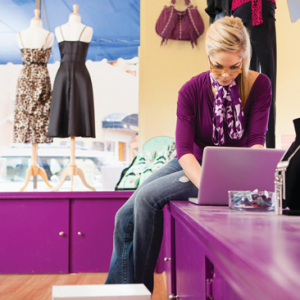Fashion Retail With A Personal Touch
 Nothing changes as quickly as fashion. Trends come and go, white is the new black, short is the new long. Can I still wear my skinny jeans? Nobody seems to know.
Nothing changes as quickly as fashion. Trends come and go, white is the new black, short is the new long. Can I still wear my skinny jeans? Nobody seems to know.
For consumers, the constant shifts and the cacophony of choices can lead to major confusion and inertia on the shopping front. So the smart fashion brands are those that strive to make a personal connection with their customers—those brands that help solve people’s problems, fulfill their needs, home in on their niches and help them discover new things to love (or rediscover old ones—my feet thank you for the comeback, Birkenstock).
For many brands, this means bypassing traditional media (along with the huge expenses that come with advertising in the likes of Vogue) and focusing on social networks to build awareness and anticipation for new items.
While many have cannily harnessed Instagram, Pinterest, Tumblr, Facebook and Twitter to grow their audiences, some fashion e-tailers have leapfrogged ahead to develop unique marketing initiatives. Among them:
- Net-a-Porter rewards influencers with its invitation-only social network Netbook. Other social apps include The Hunt and Whisp, a messaging service that lets users ask their friends “Does this skirt make me look fat?”
- Pose, ShopStyle, Asos, Polyvore have social elements that let you browse and buy, share your purchases and receive alerts on sales.
- Wish (which recently raised $50 million) offers its 31 million users a feed of discounted products from multiple online merchants.
- PS Dept lets you ask experts at major brands to hunt down a hot accessory or clothing item.
- Fashion-recognition apps like Asap54 and Slyce link brands with buyers.
- Stuck with a jacket you don’t like now that you see it with your pants? Sell it via Poshmark’s site/app. Or Vinted. Or Bib + Tuck, Tradesy, or Reissued.
With digital commerce expected to grow 17% a year for the next three years, online shopping platforms will be putting extra stress on physical retail. In fact, young consumers especially are foregoing the physical for the virtual. But the need to try clothing on for size, see how a color looks against your skin or just plain instant gratification (“I need to wear this tonight!”) gives brick-and-mortar clothing stores some leverage IRL – and they are fighting back, at street level and on iPads and smartphones. Some examples:
- Bergdorf Goodman has joined with fashion labels like Theory and Stella McCartney to be part of the aforementioned PS Dept.
- Saks introduced an app for iPhone and iPad in 2011, allowing for instant shopping, generating wish lists and other functions.
- The Macys app, also introduced in 2011, contains indoor GPS to direct shoppers through its massive Herald Square flagship.
- Earlier this year Barneys and Neiman Marcus introduced iPad and iPhone apps for shopping, browsing lookbooks and receiving personalized recommendations.
- H&M has an online catalog that lets users “remix” it like music.
The fashion industry is encouraging tech entrepreneurs to ramp up their collaborations with retailers via an accelerator program called the New York Fashion Tech Lab Program. Along with marketing and data optimization, they’re seeking solutions for manufacturing and supply-chain issues.
It’s true that mobile commerce still brings in even less revenue than traditional e-commerce. But it has proved to be the best way to forge a personal relationship with customers. And in the fickle apparel business, that can mean the difference between a major fashion moment and a faceplant on the runway.




